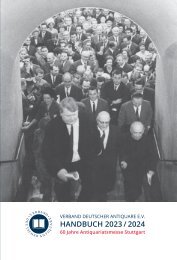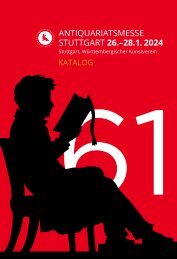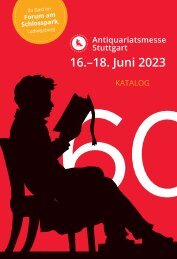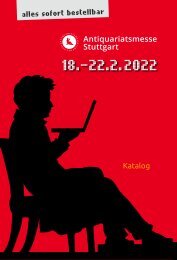Antiquariatsmesse Stuttgart 2021 - Katalog
Katalog zur Antiquariatsmesse Stuttgart 2021: Die Antiquariatsmesse Stuttgart als größtes Schaufenster für wertvolle Objekte des Antiquariats- und Graphikhandels in Deutschland findet in diesem Jahr in ungewohnter Form statt. Da eine Präsenzmesse nicht stattfinden kann, haben sich 76 Kollegen aus Deutschland, Großbritannien, Österreich, Frankreich, der Schweiz, den Niederlanden, den Vereinigten Staaten und aus Australien zusammengefunden, um einen Katalog für die Messe zu erstellen und gleichzeitig ein Angebot für eine virtuelle Messe zusammengetragen. Der Katalog wird am 7. Januar 2021 an interessierte Kunden verschickt, die virtuelle Messe öffnet ihre „digitalen Pforten“ am 29. Januar 2021 um 12.00 Uhr unter www.antiquariatsmesse-stuttgart.de
Katalog zur Antiquariatsmesse Stuttgart 2021: Die Antiquariatsmesse Stuttgart als größtes Schaufenster für wertvolle Objekte des Antiquariats- und Graphikhandels in Deutschland findet in diesem Jahr in ungewohnter Form statt. Da eine Präsenzmesse nicht stattfinden kann, haben sich 76 Kollegen aus Deutschland, Großbritannien, Österreich, Frankreich, der Schweiz, den Niederlanden, den Vereinigten Staaten und aus Australien zusammengefunden, um einen Katalog für die Messe zu erstellen und gleichzeitig ein Angebot für eine virtuelle Messe zusammengetragen.
Der Katalog wird am 7. Januar 2021 an interessierte Kunden verschickt, die virtuelle Messe öffnet ihre „digitalen Pforten“ am 29. Januar 2021 um 12.00 Uhr unter www.antiquariatsmesse-stuttgart.de
Erfolgreiche ePaper selbst erstellen
Machen Sie aus Ihren PDF Publikationen ein blätterbares Flipbook mit unserer einzigartigen Google optimierten e-Paper Software.
The birth of modern anatomy:
a coloured copy of the first edition, used by the surgeon of the Duke of Saxony
Vesalius, Andreas. De humani corporis fabrica libri
septem. Basel, (Johannes Oporinus, June 1543).
Folio (319 × 456 mm). 355 leaves and two folding
sheets. Roman and italic types, occasional use of
Greek and Hebrew types, printed shoulder notes.
Woodcut pictorial title, author portrait, and printer’s
device; 7 large, 186 mid-sized, and 22 small woodcut
initials; more than 200 woodcut illustrations,
including 3 full-page skeletons, 14 full-page muscle
men, 5 large diagrams of veins and nerves, 10 midsized
views of the abdomen, 2 mid-sized views
of the thorax, 13 mid-sized views of the skull and
brain, and numerous smaller views of bones, organs
and anatomical parts. All woodcuts and initials
up to page 165 in full contemporary hand colour.
Contemporary blindstamped leather over wooden
boards with bevelled edges, on five raised double
bands, with two clasps. In custom-made solander
box. € 950 000,–
A truly outstanding copy of one of the greatest and
most appealing books in the history of science. Preserved
in its original binding with the blindstamped
initials of its first owner, the German physician Caspar
Neefe (1514–79), and with his handwritten annotations
throughout, the present copy is partly coloured by
a contemporary artist (including the iconic woodcut
used as title-page and all anatomical illustrations up
to page 165). Caspar Neefe, who later served as personal
physician to Duke Albert I of Saxony, acquired
the precious volume only a year after its publication
and obviously consulted it extensively throughout
his career as a medical practitioner. – With the publication
of “De humani corporis fabrica” (when he
was only twenty-eight) Vesalius revolutionized both
the science of anatomy and how it was taught. In his
preface he describes his disappointing experiences as
a student in Paris and Louvain, stating his intention
to reform the teaching of anatomy by giving in this
book a complete description of the structure of the
human body, thereby drawing attention “to the falsity
of Galen’s pronouncements”. Vesalius also broke with
tradition by performing dissections himself instead of
leaving this task to assistants: the striking and dramatic
title illustration shows him conducting such a dissection,
his hand plunged into a female cadaver (striking
in itself, as only the cadavers of executed criminals
could be dissected legally and female criminals were
rarely executed), surrounded by a seething mass of
students. – The “Fabrica” is also revolutionary for “its
unprecedented blending of scientific exposition, art and
typography” (Norman). The woodcuts by artists of
the school of Titian are both iconographically and artistically
important. The series of fourteen muscle men
show landscapes that, when assembled in reverse order,
form a panorama of the Euganean Hills near Padua, a
scenery well known to Vesalius while he was at work
on the Fabrica. – Of the few copies of the first edition
to have come to the market in recent decades, only two
were in a contemporary binding. Apart from Vesalius’s
dedication copy to Emperor Charles V (Christie’s New
York, 18 March 1998, lot 213: $ 1,652,500), only a single
other partly coloured copy was previously known, a list
to which ours must now be added as the third known
copy in contemporary colour. – Acquired in 2017;
previously in a Tyrolean private medical collection,
where the book rested for three generations (erased
circular library stamp in the blank lower margin of the
title-page): an outstanding copy hitherto unknown to
scholarship (cf. the recent census published by Dániel
Margócsy, University of Cambridge, below; further
relevant correpondence with Dr Margócsy is available
upon request). Occasional waterstaining to margins,
the splendid binding a little rubbed and bumped, but
altogether a wonderfully crisp, wide-margined copy
of the first edition. Unquestionably the most desirable
copy of a milestone in the history of science still in
private hands, and likely the most important medical
book obtainable for decades to come.
PMM 71. VD 16, V 910. Durling 4577. Cushing VI.A.1.
Eimas 281. Norman 2137. Wellcome 6560. Graesse
VI.2, 289. Cf. D. Margócsy, M. Somos, S. N. Joffe:
“Vesalius’ Fabrica: A Report on the Worldwide Census
of the 1543 and 1555 Editions”, in: Social History
of Medicine Vol. 30, No. 1, pp. 201–223. For Neefe
cf. A. Lesser, Die albertinischen Leibärzte (Petersberg
2015), p. 71–74.
127






